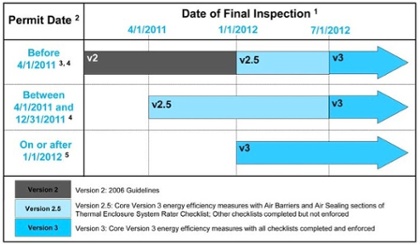The Deadline Looms for ENERGY STAR Version 3 New Homes

 On 1 July 2012, the ENERGY STAR new homes program moves fully (well, almost) into Version 3. Currently, the ENERGY STAR team at the US EPA is up to Revision 5 of Version 3, and some items have been delayed, but Version 3 kicks in for good 10 days from now. Really!
On 1 July 2012, the ENERGY STAR new homes program moves fully (well, almost) into Version 3. Currently, the ENERGY STAR team at the US EPA is up to Revision 5 of Version 3, and some items have been delayed, but Version 3 kicks in for good 10 days from now. Really!
On 1 July 2012, the ENERGY STAR new homes program moves fully (well, almost) into Version 3. Currently, the ENERGY STAR team at the US EPA is up to Revision 5 of Version 3, and some items have been delayed, but Version 3 kicks in for good 10 days from now. Really!
If you’re a home builder, HVAC contractor, or HERS rater, it’s time to kick it into high gear and finish up any houses that have a chance of getting done before 1 July. As long as they were permitted before this year, they can still qualify under Version 2.5 of the program. The implementation schedule depends on two dates, in case you need a refresher: the date the permit was issued and the date of the HERS rater’s final inspection. The chart below shows you the details.

So, what are the big issues with qualifying new homes under ENERGY STAR Version 3? There are a few, and they add up. We’ve qualified a lot of V2.5 homes and a few V3 homes through Energy Vanguard Energy Ratings, our HERS rating providership, and here are three obstacles that we’re seeing:
-
Bath fans – ES V3 requires
 bath fans to be able to exhaust 50 cubic feet per minute (cfm) of air. The HERS rater has to measure it, too, so when builders put in 50 cfm bath fans, they’re probably not going to pass. The typical bath fan moves only half its rated air flow, so a 50 cfm fan won’t cut it for ENERGY STAR. One problem is the duct that makes an immediate 180° turn (as shown in the photo at left), but there are other reasons bath fans underperform, too.
bath fans to be able to exhaust 50 cubic feet per minute (cfm) of air. The HERS rater has to measure it, too, so when builders put in 50 cfm bath fans, they’re probably not going to pass. The typical bath fan moves only half its rated air flow, so a 50 cfm fan won’t cut it for ENERGY STAR. One problem is the duct that makes an immediate 180° turn (as shown in the photo at left), but there are other reasons bath fans underperform, too. - HVAC contractors – ENERGY STAR V3 expects a lot of HVAC contractors. On the whole, they had great difficulty with the minimal V2 program requirements (Manual J, properly sized cooling system, coils matched according to AHRI standards). Now they have to do full HVAC design and commissioning and get certified through the Quality Assurance program of the Air Conditioning Contractors of America (ACCA). The fees for that are over $1000 to get started and then about $820 per year (not including ACCA membership) to continue. Not many have done it yet. There are only 12 Georgia HVAC contractors listed on the ACCA website as of today. Even in Texas, which has probably had more homes qualify for ENERGY STAR than any other state, only 63 HVAC contractors are listed.
- Cost – ENERGY STAR has a document that shows their projections for the extra costs and savings (pdf) associated with qualifying a home for Version 3 versus having it meet the 2009 IECC. They say it will cost a home builder in the range of about $3500 to over $9000, depending on location, to qualify for ENERGY STAR V3. The problem is that the builder doesn’t realize the savings; the homeowner does. Also, they’re comparing ES V3 costs to the costs to build to the 2009 IECC, which not everyone is doing yet.
Of course, these aren’t the only things that builders are balking at and getting stuck on. The requirement that all homes must have mechanical ventilation systems and grade I insulation installation (or continuous insulation) are a couple of others.
So, with the deadline looming, what happens next? ENERGY STAR Version 3 is no longer an entry level energy efficiency program. What are you seeing out in the field?
Related Articles
5 Reasons Bath Fans Have Such Poor Air Flow
ENERGY STAR Version 3 vs. the HERS Index
ENERGY STAR Homes Version 3 – Lowering the HERS Index
ENERGY STAR 2011 – Version 3 of the New Homes Program (a bit oudated but still a useful overview)
This Post Has 4 Comments
Comments are closed.

Does it not look likely
Does it not look likely builders will jump off the Energy Star bandwagon, possibly embracing HERS rating instead (or not)? On the surface this looks like one more bureaucratic program that got too ambitious and complex for its original mission. If that is the case, it is a blessing that the end game might be irrelevancy, as paying for Energy Star is optional.
Mark J.:
Mark J.: Yes, some builders are jumping ship and instead just getting HERS ratings so they can market their HERS Index. See the second article in my list of links at the bottom of the article above for more about that shift.
Sam Rashkin, the brilliant
Sam Rashkin, the brilliant daddy of Energy Star for Homes, sang his Version 3 swan song and then moved on to DOE. Good timing. Energy Star, because it insists on being a program always above code, over-reached and shot itself in the foot. I actually heard Sam say he was not necessarily in favor of ever more stringent energy codes because it meant ES had to keep upping the ante also.
HERS and RESNET are a juggernaut that is quickly being embraced by America’s production builders. That speaks to massive market penetration because they are the only ones building. And that is because they finance through shareholders instead of local banks. Now we just need to convince RESNET that mandatory Thermal Bypass and air barrier inspections should be part of the protocol, and that when homes test tighter than .35 air exchanges per hour some mechanical ventilation is be required.
Allison, the start up
Allison, the start up procedures required by the HVAC equipment manufacturer’s are all that the V3 checklists are documenting. For all of the production builders whose HVAC contracts I have reviewed, they have been required to do all of these items for many years. In most cases, the equipment manufacturer can void a warranty claim if these start-up procedures are not documented. Its all about accountability. The ACCA part is understandably a challenge for many. Where HVAC contractors have said V3 will cost you (the builder) more than 2.5, most have plenty of others lined up ready to take the job.